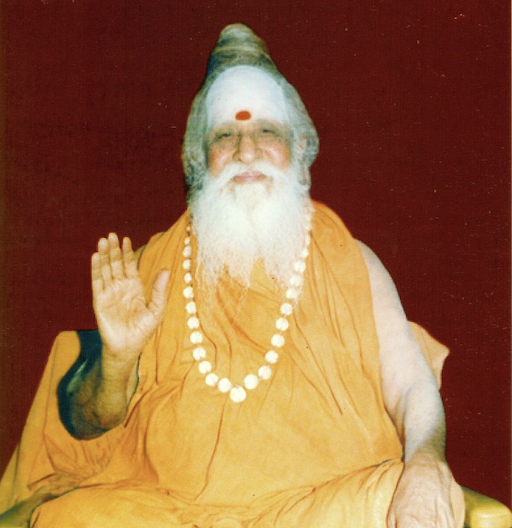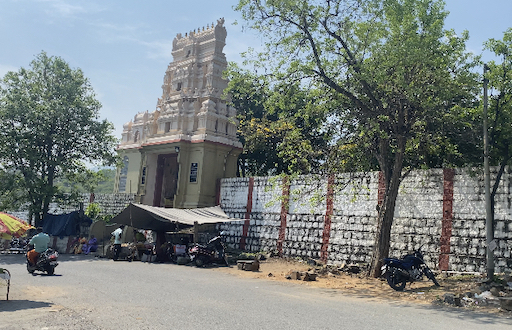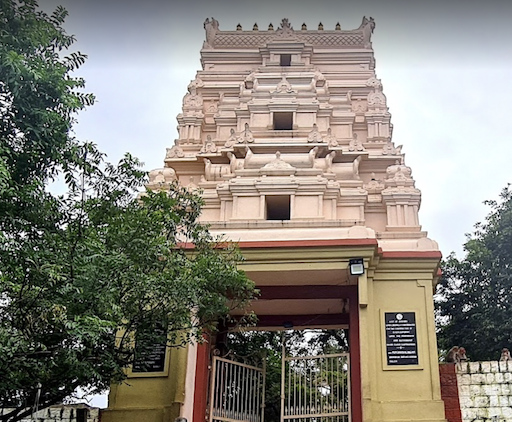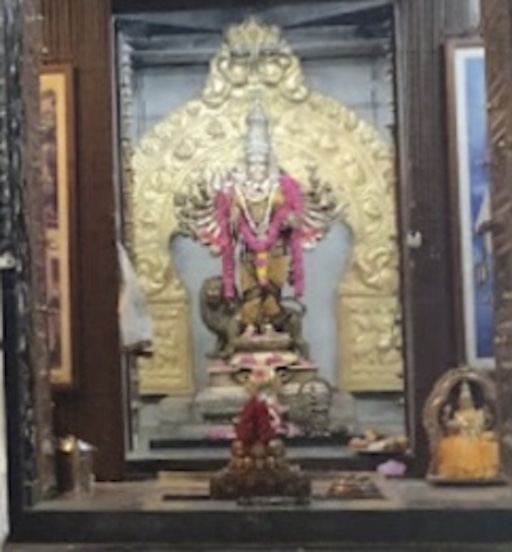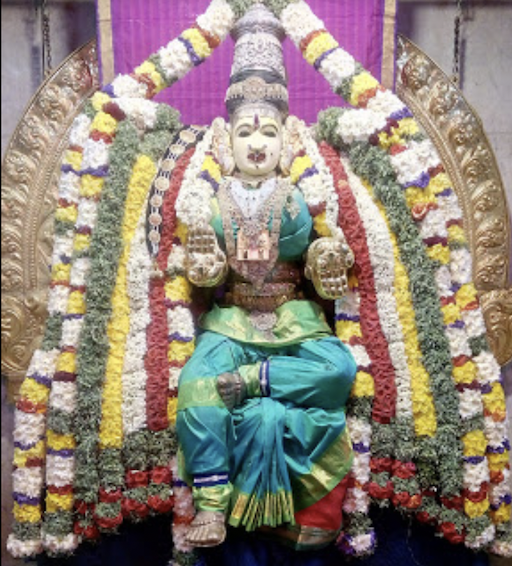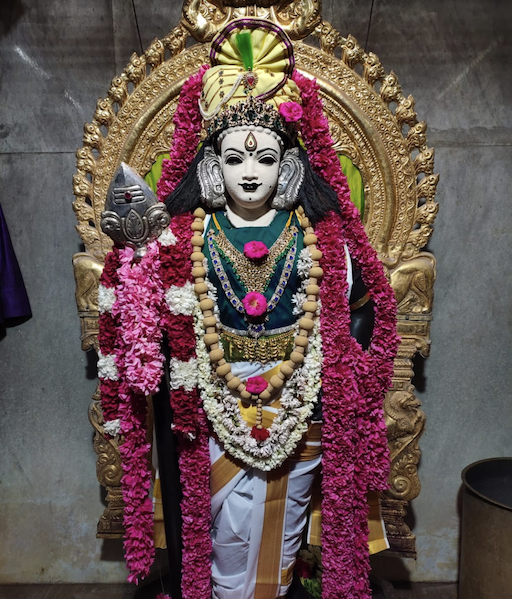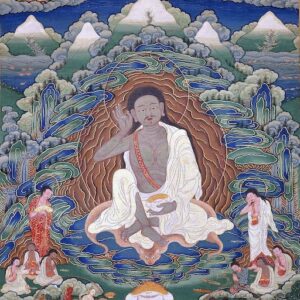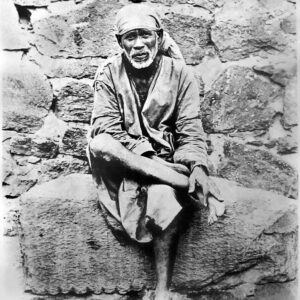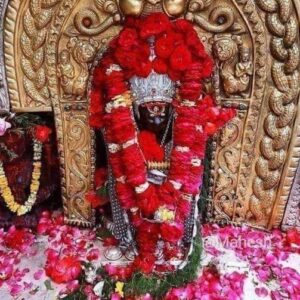This is a Jeevasamadhi of Sri Santhananda Saraswathi Avadootha Swamigal. His jeevasamadhi is inside the Skandasramam Murugan Temple in Salem. He was a disciple of Shri Swayamprakash Avadootha Swamigal.
There is a place of sit and mediate close to the Jeevasamadhi. You can go into meditative states here effortlessly.
How to get there
The jeevasamadhi is located 12 kms East of Salem.
Map: https://goo.gl/maps/zXLMX1gaiiSRqKQ47
About Shri Santhananda Avadootha Swamigal
In a small village near Madurai there lived an orthodox Brahmin family. The couple were great devotees of Meenakshi. They had nine children. A famous ascetic of the time. Mayandi Yogi, visited them one day. He predicted that they would have one more child, their tenth. “A son would be born. He would be a votary of the Vedas, a supporter of yagnas, a repository of knowledge, an ideal disciple, a man of action for the welfare of the world and a devotee of goddess Bhuvaneswari. Call him Subrahmanya. He will be yours only during his formative years. Then the world gets the monopoly over him. Like Adi Sankara who left his house and village when he was barely eight, your would-be son also would leave you behind. As you would be instrumental in causing his birth, you would get salvation automatically. Therefore from now onward you should cultivate detachment towards your would-be son so that you would not obstruct him when the time came for him to renounce worldly life”.
Mayandi Yogi had the gift for looking into the seeds of time and saying which grain will grow and which will not. Hit prophecy was fulfilled. Sixty years ago a son was born to the pious couple. They called him Subrahmanayam. It was an apt name. Lord Subrahmanya dares to teach even Lord Siva, his father. He is the God of spiritual knowledge, the deity of yagnas and the supreme commander of the divine army. He appears in the form of iridescent flame. He blesses His devotees with youth, beauty and knowledge.
At the appropriate age the boy was admitted in a school. He had phenomenal memory. Whatever he learnt at school he was able to retain it. Whenever he had leisure he spent his time in the Meenakshi Temple. One can say that he had learnt everything in his previous birth his message-not to learn, but to teach; not to be ministered unto, but to minister.
Mayandi Yogi made another visit to the boy’s house. He was thrilled to see the boy. He suggested that the boy be admitted in a Sanskrit school to learn the Vedas and be sent to him after his studies were over. Accordingly the boy was admitted in the Naganatapuram Veda Patasala, Karaikudi. In course of time, Subrahmanyam became well versed in the Vedas.
Then he approached Mayandi Yogi, who was extremely happy that notwithstanding an eventful
life, Subrahmanyam did not fail to turn up when the hour arrived. He taught the youth the art of meditation and explained the monosyllabic mantra of Goddess Bhuvaneswari. He asked him to chant it unceasingly so that he could have mastery over the sense. He further advised him to remain silent and to subsist on alms and also not to stay at a place for long.
Brahmachari Subrahmanyam began his wanderings. He visited many places — Agastya Hill, Courtalam, Tiruchendur, Tirupati, Tirunelveli, Palani, to name a few — and did penance there. Sometimes he was mistaken for a child lifter and beaten or handed over to the police. As he kept the vow of silence, he was kept in custody for some days before he was found innocent and released.
Subrahmaniyam traveled everywhere on foot and survived on alms. He did penance at many sacred places. Then he commenced his pilgrimage to North India. He visited Badrinath, Kedarnath, Nepal and Rishikish. He stayed for some time in Rishikesh and served Swami Sivananda.
Here was an ideal disciple whom many preceptors longed to adopt. But Subrahmanyam was searching for some other type of Guru. He searched everywhere — in forests and mountains, on river banks and in temples.
Once in the Nellaiappar Temple, Tirunelveli, When he went on dashing his head against the floor, as a part of his penance, he had the vision of an avadhuta commanding him to follow. As soon as he got up, the vision disappeared. But he often heard the echo of the command. He was Searching for only that particular avadhuta so as to become his disciple.
On the Girnar Hill, Gujarat, there is a holy place known as Śrī Datta Paduka Peetham. It is a favorite haunt of ascetics. Tradition is that only after initiation, avadhutas used to visit here. Subrahmanyam reached there even before his initiation.
It is an arduous task to climb the hill and reach its top. The place was surrounded by dense forests and was the habitat of wild animals. One had to climb hundreds of steps to reach the top. Subrahmanyam was indisposed and weak.
An unknown sadhu appeared and said. Why do you hesitate? Datta Guru is always with you. You swallow this pill and ascend the hill’. He vanished. Who was he, whence he came, and why? Nobody knew.
Subrahmanyam swallowed the pill. He felt rejuvenated and light. His mind became alert and his body strong. He climbed the hill and had the darshan of Datta paduka. He heard a voice commanding him to go to Sendamangalam (Salem district) where a Guru was waiting.
One day he reached Sendamangalam and had the darshan of Swami Swayamprakasaji. At once he realized that the avadhuta he saw in a vision at Tirunelveli was none other that Swamiji and requested that he be accepted as a disciple.
On the Girnar Hill, Gujarat, there is a holy place known as Śrī Datta Paduka Peetham. It is a favorite haunt of ascetics. Tradition is that only after initiation, avadhutas used to visit here. Subrahmanyam reached there even before his initiation.
It is an arduous task to climb the hill and reach its top. The place was surrounded by dense forests and was the habitat of wild animals. One had to climb hundreds of steps to reach the top. Subrahmanyam was indisposed and weak.
Santanandaji arrived at Pudukkottai. The Adhishtanam was in the midst of a grove of neem trees. There was a small tower above the tomb. Santanandaji scrupulously followed his Guru’s command. He did not talk to anybody. He stayed near the Adhishtanam day and night. Whenever hungry, he simply ate the neem leaves. In sun and rain he took shelter under a tree.
Devotes started to trickle in. They were impressed by the austerity of the young Swami. They not only gave him food but also built a small room close to the Adhishtanam.
A year was over. The vow of silence too was fulfilled. Swamiji explained to the devotees the reason for his arrival and stay. Advocate Sri. P. Balasubrahmanya Sastri, the owner of the land, made deed of gift and relinquished his right over the land where the crypt existed. Then Swamiji arranged for a huge painting of Bhuvaneswari and continued his meditation in its presence.
